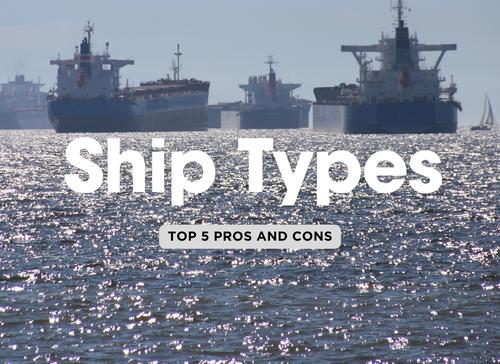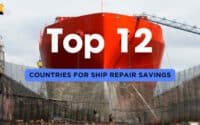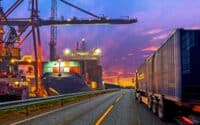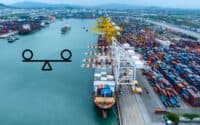The Top 5 Pros and Cons of the 12 Major Ships on the Market

For shipowners, understanding the pros and cons of different vessel types can help guide decisions around fleet composition, operational focus, and investment strategies. From container ships and oil tankers to bulk carriers and reefer vessels, each type has its own strengths and trade-offs that impact everything from fuel efficiency and capacity to flexibility and maintenance costs. Today we dive into the top 5 pros and cons of each vessel type.
** Please send comments/suggestions to editor at shipuniverse.com
Container Ships
Container ships are the workhorses of global trade, moving the vast majority of manufactured goods across the seas. Known for their capacity to efficiently transport standardized shipping containers, these vessels play a critical role in intermodal transport, allowing goods to be easily transferred between trucks, trains, and ships. However, despite their efficiency, container ships come with specific challenges that shipowners need to consider.
| ShipUniverse: Container Ships - Top 5 Pros and Cons | ||
|---|---|---|
| Aspect | Pros | Cons |
| Efficiency | High efficiency for transporting large volumes of containerized cargo, reducing per-unit shipping costs. | Container handling requires specialized port infrastructure, limiting accessible ports and increasing dependency on specific routes. |
| Intermodal Compatibility | Seamlessly connects with truck and rail for easy transfer of goods, enhancing supply chain flexibility. | Limited by strict container size standards, making it less ideal for irregular or oversized cargo. |
| Speed | Designed for faster transit times compared to bulk carriers, meeting time-sensitive delivery needs. | Higher speeds lead to increased fuel consumption and emissions, impacting operational costs and environmental footprint. |
| Maintenance | Relatively standardized design lowers maintenance costs, as parts and expertise are widely available. | Susceptible to wear from frequent port stops and handling, requiring regular inspections and repairs. |
| Revenue Potential | High cargo capacity maximizes revenue per trip, especially on popular trade routes. | Demand volatility in global trade can impact profitability, with container shipping rates subject to economic shifts. |
Bulk Carriers
Bulk carriers are the backbone of global commodity transport, specifically designed to move unpackaged goods like coal, grain, and minerals. With large open cargo holds, they offer efficient solutions for transporting massive quantities of raw materials in a single trip. However, operating bulk carriers comes with its own set of considerations, such as port limitations and load restrictions.
| ShipUniverse: Bulk Carriers - Top 5 Pros and Cons | ||
|---|---|---|
| Aspect | Pros | Cons |
| Capacity | Designed for massive cargo loads, making them highly efficient for transporting bulk materials in a single trip. | Loading and unloading bulk cargo can be time-intensive, impacting turnaround times and port fees. |
| Versatility | Can carry a wide range of bulk goods, from agricultural products to minerals, making them versatile in the commodities market. | Bulk cargo can shift during transit, requiring careful loading and additional ballast water management for stability. |
| Lower Operating Costs | Generally lower operating costs per ton of cargo transported compared to container ships. | More susceptible to port restrictions and regulations, limiting access to certain ports and routes. |
| Market Demand | Bulk carriers are in high demand for essential commodities, offering stable market opportunities. | Vulnerable to market fluctuations; a decline in commodity prices can significantly impact profitability. |
| Construction Simplicity | Simple construction and fewer moving parts reduce maintenance costs and ease of repairs. | Less flexibility in cargo types compared to container ships, as they are limited to unpackaged materials only. |
Oil Tankers
Oil tankers play a vital role in transporting crude oil and refined petroleum products across the globe. With their large capacity and specialized compartments, they are engineered to carry massive quantities of liquid cargo efficiently. However, oil tankers come with unique challenges, such as strict safety regulations, environmental concerns, and port access limitations.
| ShipUniverse: Oil Tankers - Top 5 Pros and Cons | ||
|---|---|---|
| Aspect | Pros | Cons |
| Capacity | Exceptional capacity for carrying liquid cargo, making them highly efficient for transporting crude oil and petroleum over long distances. | Requires significant infrastructure for loading and unloading, limiting port accessibility and adding logistical complexities. |
| Profitability | High revenue potential due to the value of the cargo, particularly on busy trade routes and in times of high oil demand. | Operating costs are high, with a need for specialized crew and safety measures that increase ongoing expenses. |
| Specialized Design | Double hull design and safety features reduce the risk of spills, meeting international regulations and ensuring safer transport. | Requires strict adherence to environmental regulations, leading to higher compliance costs and potential delays. |
| Reliability | Oil tankers are built for durability and are reliable for long-haul journeys in various weather conditions. | Highly vulnerable to oil market volatility; fluctuations in oil demand and prices can significantly impact profit margins. |
| Global Demand | Consistently high demand for oil transport ensures regular work, providing a steady revenue stream for operators. | Environmental concerns and public scrutiny can affect reputational risk and operational freedom. |
LNG and LPG Carriers
LNG and LPG carriers are specialized vessels designed to transport natural gas and petroleum gas in a liquefied state, addressing the increasing global demand for energy. With specialized tanks that maintain extremely low temperatures, these carriers offer efficient, large-scale transport of gases that would otherwise be challenging to move. However, they also come with high operational and safety requirements, making them both costly and complex to operate.
| ShipUniverse: LNG and LPG Carriers - Top 5 Pros and Cons | ||
|---|---|---|
| Aspect | Pros | Cons |
| Capacity | Efficiently transports large quantities of gas in liquid form, maximizing load capacity for global distribution. | Requires advanced insulation and refrigeration technology, increasing initial build and maintenance costs. |
| Safety | Advanced safety systems, including double-hulled designs and pressure controls, reduce risk of leaks and explosions. | Complex safety measures make these carriers costly to operate and maintain, with mandatory compliance to strict international regulations. |
| Revenue Potential | High demand for LNG and LPG globally offers stable revenue, especially in regions transitioning to cleaner fuels. | Market fluctuations in gas prices can impact revenue, making profitability more variable. |
| Environmental Benefit | LNG is considered a cleaner fuel option, supporting environmental goals and potentially reducing emissions for the transport sector. | Risk of environmental damage remains high in case of accidents, which can lead to significant fines and public backlash. |
| Technical Expertise | Specialized technology and trained crew enhance operational safety and efficiency. | Requires highly skilled crew and specialized training, increasing labor costs and limiting availability of qualified personnel. |
Roll-On/Roll-Off (RoRo) Ships
Roll-On/Roll-Off (RoRo) ships are designed for the easy loading and unloading of wheeled cargo like cars, trucks, and other vehicles. Equipped with ramps and spacious decks, these ships streamline the process of moving vehicles across oceans, making them a popular choice in the automotive and heavy machinery industries. However, the focus on wheeled cargo limits the flexibility of RoRo ships and presents specific operational challenges.
| ShipUniverse: RoRo Ships - Top 5 Pros and Cons | ||
|---|---|---|
| Aspect | Pros | Cons |
| Loading Efficiency | Efficient loading/unloading of vehicles directly via ramps, reducing turnaround time in port and labor costs. | Requires specific port infrastructure to accommodate ramps, limiting port options and increasing dependency on certain locations. |
| Versatility for Vehicle Transport | Specialized for transporting wheeled cargo, making them ideal for the automotive and heavy equipment industries. | Limited to wheeled cargo, which restricts the types of goods they can transport compared to multipurpose carriers. |
| Reduced Cargo Handling | Minimizes manual handling of cargo, reducing the risk of damage to vehicles and other wheeled equipment. | Higher vulnerability to vehicle shifting in rough seas, which can lead to cargo damage if not secured properly. |
| Operational Speed | Quick turnaround times allow for frequent trips, improving revenue potential on high-demand routes. | RoRo ships are typically slower than container ships, making them less suitable for time-sensitive cargo. |
| Revenue Stability | Steady demand from automotive and machinery industries offers consistent business opportunities. | Market demand can be seasonal and is sensitive to the economic health of specific industries, like automotive. |
General Cargo Ships
General cargo ships are designed for maximum versatility, capable of carrying a wide variety of goods, from packaged items and machinery to irregularly shaped equipment. These ships offer flexibility for transporting cargo that doesn’t fit in standardized containers or bulk holds, making them a valuable asset in regions with diverse shipping needs. However, general cargo ships face challenges related to handling different types of goods and often require specialized equipment.
| ShipUniverse: General Cargo Ships - Top 5 Pros and Cons | ||
|---|---|---|
| Aspect | Pros | Cons |
| Versatility | Can transport various types of cargo, from packaged items to machinery, making them adaptable for different markets. | Requires more time and effort to load/unload due to the varied nature of cargo, leading to longer turnaround times. |
| Market Flexibility | Suited for regions with diverse shipping needs, enabling operators to adjust to different cargo types based on demand. | More manual handling is needed, which increases labor costs and risk of cargo damage. |
| Cost Efficiency for Small Loads | Allows for profitable transport of smaller, mixed cargoes, especially useful on routes with lower volume demands. | Lower cargo capacity compared to bulk or container ships, limiting overall revenue potential per voyage. |
| Access to Smaller Ports | Can access smaller, less-equipped ports where container ships or bulk carriers may not fit, expanding route options. | Limited in rough weather conditions due to design and less robust cargo securing, increasing operational risks. |
| Revenue Opportunities | Stable revenue potential from niche markets that need specific or irregular cargo transport. | Market demand can be inconsistent, with fewer bulk contracts available, leading to potential income fluctuations. |
Reefer Ships
Reefer ships, or refrigerated vessels, are specialized to transport perishable goods like fruits, vegetables, meat, and dairy. Equipped with powerful refrigeration systems, these ships maintain specific temperatures to ensure goods arrive fresh and intact. However, reefer ships come with unique operational and maintenance challenges due to their complex cooling equipment and cargo sensitivity.
| ShipUniverse: Reefer Ships - Top 5 Pros and Cons | ||
|---|---|---|
| Aspect | Pros | Cons |
| Temperature Control | Advanced refrigeration systems maintain specific temperatures, ensuring high-quality preservation of perishable goods. | Complex refrigeration systems require frequent maintenance and monitoring, increasing operational costs. |
| High Demand for Perishables | Consistent demand for fresh produce, dairy, and meat creates steady revenue opportunities, especially on established routes. | Demand is often seasonal, leading to fluctuations in cargo availability and potential income instability. |
| Revenue Potential | Higher freight rates for temperature-sensitive goods can yield profitable returns, particularly in peak produce seasons. | Higher insurance and liability costs, given the sensitive nature of the cargo, increase overall operational expenses. |
| Flexible Cargo Types | Can carry various perishable goods, including frozen items, fresh produce, and pharmaceuticals, allowing for diverse cargo options. | Limited to temperature-sensitive goods, reducing flexibility to handle non-perishable or standard cargo if demand drops. |
| Access to Niche Markets | Serves niche markets with specific perishable needs, enabling access to specialized routes and dedicated contracts. | Specialized crew and training requirements increase labor costs and limit availability of qualified personnel. |
Chemical Tankers
Chemical tankers are specialized vessels designed to transport liquid chemicals and hazardous materials safely and efficiently. These ships are built with coated tanks and advanced safety systems to handle volatile cargo, making them essential for transporting chemicals globally. However, chemical tankers come with high regulatory requirements and specialized operational needs.
| ShipUniverse: Chemical Tankers - Top 5 Pros and Cons | ||
|---|---|---|
| Aspect | Pros | Cons |
| Specialized Transport | Equipped with coated tanks and advanced safety systems, making them ideal for transporting hazardous and sensitive chemicals. | Strict handling protocols and advanced equipment result in higher maintenance and compliance costs. |
| Revenue Potential | High freight rates due to the specialized nature of cargo provide strong revenue opportunities for operators. | Demand for chemical tankers is sensitive to economic fluctuations, particularly in the manufacturing and industrial sectors. |
| Safety Standards | Built to rigorous safety standards with features like double-hull designs and vapor recovery systems, enhancing overall safety. | Significant regulatory oversight increases administrative burden and the potential for costly penalties in case of violations. |
| Cargo Segregation | Multiple segregated tanks allow for transporting different chemicals simultaneously, increasing operational flexibility. | Segregation increases complexity in loading/unloading operations and requires specialized crew training. |
| Environmental Safeguards | Advanced systems minimize the risk of spills and leaks, meeting international environmental standards. | Environmental incidents, while rare, can lead to severe reputational and financial repercussions if they occur. |
Heavy-Lift/Project Cargo Ships
Heavy-lift and project cargo ships are designed to transport oversized, heavy, or unconventional items, such as construction equipment, wind turbine parts, and even other vessels. These ships are equipped with powerful cranes and reinforced decks, allowing them to handle cargos that standard vessels cannot accommodate. However, their specialization comes with unique operational challenges, such as high loading costs and limited cargo versatility.
| ShipUniverse: Heavy-Lift/Project Cargo Ships - Top 5 Pros and Cons | ||
|---|---|---|
| Aspect | Pros | Cons |
| Specialized Equipment | Equipped with heavy-duty cranes and reinforced decks, enabling safe handling of oversized and heavy cargos. | High cost for specialized equipment maintenance and operations, making these ships more expensive to operate. |
| Revenue Potential | High freight rates for unique and critical cargoes provide profitable opportunities, especially in industrial and infrastructure sectors. | Irregular demand, with fewer consistent contracts, can lead to periods of low utilization and income fluctuations. |
| Versatility in Cargo Size | Can transport a wide range of oversized items, offering flexibility to carry unconventional cargo like machinery, turbines, and large structures. | Limited to project-based cargo, making it less adaptable for standardized or containerized freight, which reduces overall market reach. |
| Global Demand | Rising infrastructure projects worldwide increase demand, especially in renewable energy and construction sectors. | Seasonal and project-specific demand can result in varying revenue streams and operational downtimes. |
| Operational Flexibility | Customizable deck configurations allow for tailored cargo setups, enhancing adaptability to different project needs. | Complex loading/unloading operations increase port time and labor costs, reducing turnaround efficiency. |
Offshore Supply Vessels (OSVs)
Offshore Supply Vessels (OSVs) are vital for supporting offshore oil rigs, wind farms, and other marine installations. These vessels transport equipment, supplies, fuel, and crew to and from offshore locations, often operating in challenging environments. OSVs are designed for high maneuverability and versatility, equipped to handle a variety of tasks crucial for offshore operations.
| ShipUniverse: Offshore Supply Vessels (OSVs) - Top 5 Pros and Cons | ||
|---|---|---|
| Aspect | Pros | Cons |
| Operational Versatility | Designed to handle multiple tasks, from transporting supplies to conducting rescue operations, providing flexibility for diverse offshore needs. | High operational costs due to specialized equipment and crew, making them more expensive to maintain and operate. |
| Maneuverability | Highly maneuverable to operate in close proximity to offshore platforms, enabling precise positioning even in challenging weather. | Limited to offshore and near-platform operations, making them unsuitable for standard cargo transport or long-distance shipping. |
| Specialized Equipment | Equipped with cranes, dynamic positioning systems, and helipads, providing essential support to offshore installations. | Complex equipment requires regular maintenance and skilled personnel, increasing operational and staffing costs. |
| Revenue Stability | Steady demand from the offshore oil, gas, and renewable sectors offers reliable contract opportunities. | Dependent on the health of the offshore industry, with downturns in oil prices or energy demand affecting revenue stability. |
| Safety Standards | Built to high safety standards due to hazardous offshore conditions, enhancing crew safety and reducing accident risks. | Strict regulatory requirements lead to increased compliance costs and more frequent inspections. |
Passenger Ships
Passenger ships, ranging from ferries to large cruise liners, are designed to transport people and sometimes their vehicles across water. These vessels focus on comfort, safety, and entertainment, providing a unique travel experience. While passenger ships can be profitable, especially on popular routes, they also face specific challenges such as strict safety regulations, high maintenance costs, and the impact of seasonal demand.
| ShipUniverse: Passenger Ships - Top 5 Pros and Cons | ||
|---|---|---|
| Aspect | Pros | Cons |
| Revenue Potential | High revenue from ticket sales, onboard services, and entertainment, especially on popular tourist routes and cruise lines. | High operational costs, including crew salaries, maintenance, and fuel, significantly reduce net profit margins. |
| Passenger Demand | Consistent demand for ferries and cruises, with growth in tourism and leisure industries driving steady passenger flow. | Seasonal demand fluctuations impact occupancy rates, with off-peak seasons leading to underutilization. |
| Onboard Amenities | Amenities like restaurants, shops, and entertainment increase passenger satisfaction and generate additional revenue. | Maintaining high-quality amenities increases operational complexity and costs, especially for larger ships. |
| Safety Standards | Built to rigorous safety standards to protect passengers, with trained crew and emergency systems in place. | Strict regulatory requirements for passenger safety lead to frequent inspections and compliance costs. |
| Global Reach | Passenger ships connect regions and enhance tourism, offering unique travel experiences and access to remote destinations. | Susceptible to health-related concerns (e.g., outbreaks) which can impact passenger numbers and require costly protocols. |
Fishing Vessels
Fishing vessels are crucial for harvesting and transporting seafood, supporting the global demand for fish and other marine products. These ships vary in size and type, from small trawlers to large factory ships equipped for processing catches at sea. While fishing vessels are essential for the fishing industry, they also face challenges like regulatory restrictions, seasonal demand, and environmental risks.
| ShipUniverse: Fishing Vessels - Top 5 Pros and Cons | ||
|---|---|---|
| Aspect | Pros | Cons |
| Revenue Potential | High revenue from fresh seafood sales, especially in areas with strong demand for fish and seafood. | Revenue can fluctuate based on seasonal catch limits, environmental regulations, and fish stock availability. |
| Local Employment | Creates jobs for local communities, supporting the fishing industry and boosting regional economies. | Labor costs can be high, and recruitment is challenging in remote areas, particularly for skilled crew members. |
| Onboard Processing | Larger vessels with onboard processing facilities can deliver fresh, processed products directly to markets, adding value. | Onboard processing equipment requires maintenance and adds complexity, increasing operational expenses. |
| Flexibility in Operation | Fishing vessels can operate in coastal and open ocean areas, adapting to seasonal fish migrations and market needs. | Subject to strict fishing quotas and environmental regulations, which can limit operational flexibility and profits. |
| Market Demand | Consistent demand for seafood offers stable market opportunities for fishing vessel operators. | Overfishing concerns and environmental risks, such as ocean pollution, impact long-term viability and regulatory limits. |
Each type of vessel in the maritime shipping industry plays a unique role, with its own set of strengths and challenges. For shipowners, understanding these nuances can inform better decisions regarding fleet composition, investment, and operational focus. From the highly specialized needs of LNG carriers and chemical tankers to the more flexible uses of general cargo ships and RoRo vessels, there’s a vessel type suited to every market demand and operational strategy. By considering the pros and cons of each, shipowners can better navigate the complex landscape of maritime shipping, ensuring their fleet choices align with their business goals and industry trends.

Do you have a Maritime Product or Service that may be of interest to Shipowners? Tell us about it here!
Do you have feedback or insights? Please reach out to editor @ shipuniverse.com



